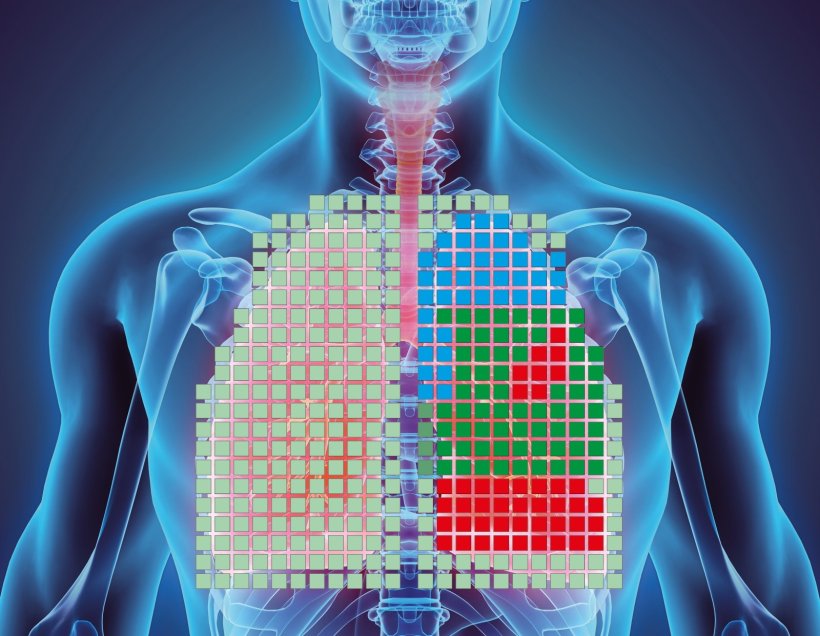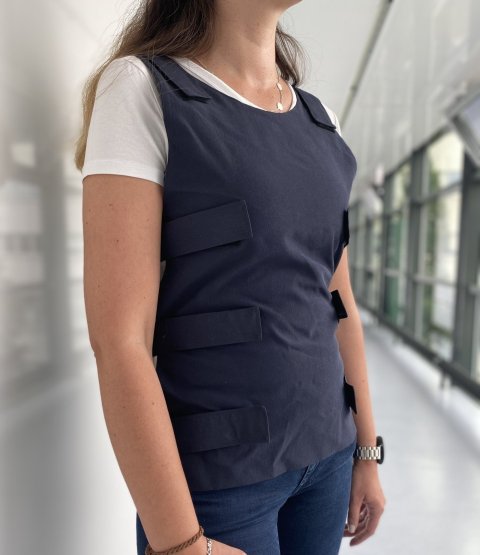
© Fraunhofer IKTS
News • Wearable sensor array
High-tech vest monitors lung function
Patients with severe respiratory or lung diseases require intensive treatment and their lung function needs to be monitored on a continuous basis. As part of the Pneumo.Vest project, Fraunhofer researchers have developed a technology whereby noises in the lungs are recorded using a textile vest with integrated acoustic sensors.
The signals are then converted and displayed visually using software. In this way, patients outside of intensive care units can still be monitored continuously. The technology increases the options for diagnosis and improves the patient’s quality of life.
Our technology provides added value because it allows for the lungs to be monitored continuously in the same way as a long-term ECG, even if the patient is not attached to machines in the ICU
Ralf Schallert
As part of the Pneumo.Vest project, researchers of the Fraunhofer Institute for Ceramic Technologies and Systems IKTS at the Berlin office have developed a textile vest with integrated acoustic sensors, presenting a high-performance addition to the traditional stethoscope. Piezoceramic acoustic sensors have been incorporated into the front and back of the vest to register any noise produced by the lungs in the thorax, no matter how small. A software program records the signals and electronically amplifies them, while the lungs are depicted visually on a display. As the software knows the position of each individual sensor, it can attribute the data to its precise location. This produces a detailed acoustic and optical picture of the ventilation situation of all parts of the lungs. As the system collects and stores the data permanently, examinations can take place at any given time and in the absence of hospital staff. Pneumo.Vest also indicates the status of the lungs over a period of time, for example over the previous 24 hours. Needless to say, traditional auscultation can also be carried out directly on the patients. However, instead of carrying out auscultation manually at different points with a stethoscope, a number of sensors are used simultaneously.
“Pneumo.Vest is not looking to make the stethoscope redundant and does not replace the skills of experienced pneumologists. However, auscultation or even CT scans of the lungs only ever present a snapshot at the time of the examination. Our technology provides added value because it allows for the lungs to be monitored continuously in the same way as a long-term ECG, even if the patient is not attached to machines in the ICU but has instead been admitted to the general ward,” explains Ralf Schallert, project manager at Fraunhofer IKTS.

© Fraunhofer IKTS
Alongside the acoustic sensors, the software is at the core of the vest. It is responsible for storing, depicting and analyzing the data. It can be used by the doctor to view the acoustic events in specific individual areas of the lungs on the display. The use of algorithms in digital signal processing enables a targeted evaluation of acoustic signals. This means it is possible, for example, to filter out heartbeats or to amplify characteristic frequency ranges, making lung sounds, such as rustling or wheezing, much easier to hear. On top of this, the researchers at Fraunhofer IKTS are developing machine learning algorithms. In the future, these will be able to structure and classify complex ambient noises in the thorax. Then, the pneumologist will carry out the final assessment and diagnosis.
Patients can also benefit from the digital sensor alternative. When wearing the vest, they can recover without requiring constant observation from medical staff. They can transfer to the general ward and possibly even be sent home and move about more or less freely. Despite this, the lungs are monitored continuously, and any sudden deterioration can be reported to medical personnel straight away.
The combination of acoustic sensors, visualization and machine learning algorithms will be able to reliably distinguish a range of different lung sounds
Ralf Schallert
The first tests with staff at the University Clinic for Anesthesiology and Intensive Therapy at the University of Magdeburg have shown that the concept is successful in practice. “The feedback from doctors was overwhelmingly positive. The combination of acoustic sensors, visualization and machine learning algorithms will be able to reliably distinguish a range of different lung sounds,” explains Schallert. Dr. Alexander Uhrig from Charité – Universitätsmedizin Berlin is also pleased with the technology. The specialist in infectiology and pneumology at the renowned Charité hospital was one of those who initiated the idea: “Pneumo.Vest addresses exactly what we need. It serves as an instrument that expands our diagnostic options, relieves the burden on our hospital staff and makes hospital stays more pleasant for patients.”
The technology was initially designed for respiratory patients, but it also works well for people in care facilities and for use in sleep laboratories. It can also be used to train young doctors in auscultation.
The vest is cut out for the increasingly strained situation at hospitals. In Germany, 385,000 patients with respiratory or lung diseases require inpatient treatment every year. Over 60 percent are connected to a ventilator for more than 24 hours. This figure does not account for the current increase in respiratory patients due to the Covid-19 pandemic. As a result of increasing life expectancy, the medical industry also expects the number of older patients with breathing problems to increase. With the help of technology from Fraunhofer IKTS, the burden on hospitals and, in particular, costly ICUs can be relieved as their beds will no longer be occupied for quite as long.
It should be added that the market for such clinical-grade wearables is growing rapidly. These are compact medical devices that can be worn directly on the body to measure vital signs such as heartbeat, blood oxygen saturation, respiratory rate or skin temperature. As a medical device that can be used flexibly, Pneumo.Vest fits in perfectly with this development. But do not worry: Doctors will still be using the beloved stethoscope in the future.
Source: Fraunhofer Institute for Ceramic Technologies and Systems IKTS
02.08.2022









